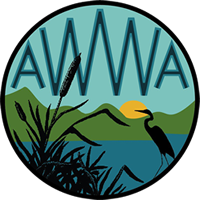I’ve been unable to post a blog for our winter series, Exploring the Winter Rivers, for the past few weeks. This is primarily due to the flurry of winter trainings and conferences that AWWA’s been attending in order to keep up to date on the best stormwater implementation and outreach methods. However, once I knew Dr. Haney was coming up to Province Lake this winter, I knew it would be something I had to tell you all about.
Dr. Haney had last come to Province Lake in September 2013 with his field limnology class to do sampling on the waters of Province Lake. One of the most valuable tests which he was performing was a sediment core analysis, sediment core analyses are particularly valuable because, unlike other tests which give us a snapshot of the lake, a sediment core analysis can give us a look at the history of the lake. This is particularly useful on Province Lake, where the history of the lake is murky at best and one historical document seemingly contradicts the last. While a core sample was obtained in September, Dr. Haney was not sufficiently pleased with the depth of the sample. It seemed as though the core sampler wasn’t penetrating the sediments as far as it should have. Typically, Dr. Haney is able to gather information dating back to pre-development times, but our first sample was only able to take us back several decades. A plan was made to perform winter sampling, hoping the ice would give us a more stable launching pad for the sediment corer.
Yesterday gave us another opportunity to attempt a sediment core grab. Dr. Haney, his student John DuFresne, and past student Nancy Leland were all in attendance, as well as members of the Province Lake Association, AWWA, and NH DES. We loaded up the snowmobiles (provided by members of PLA) and headed out to the deepest spot of Province Lake.
With motorized augers, we were able to quickly drill through the ice in seconds.
Nancy Leland and Linda Schier dropped a plankton net through one of the holes, collecting both phyto and zooplankton. The number and variety of plankton which are present in Province in winter will give us a clearer picture of Province Lake’s ecology throughout the year. The phyto and zooplankton are separated through a simple device which attracts the zooplankton to the light. Within 20 minutes, we can be sure that 95% of the zooplankton will have gone down into the light exposed tube.
At the sediment coring station, however, things were not looking as promising. Repeated attempts at different sections of the lake yielded nothing but murky water, with the corer failing to penetrate the sediment layer. Typically, with the amount of weight Dr. Haney attached to the corer yields almost too much sediment, filling the tube entirely. This time however, we were lucky to get an inch. It appears as though Province Lake either has an abnormally hard sediment layer, the layer is incredibly small, or as Dr. Haney suggested, the lake churns sediments enough to keep them from forming a consolidated layer of sediment, instead leading to several feet of murky water at the bottom of the lake.
This is not a failure though, merely another piece of Province’s puzzle. Dr. Haney believes that the next step will be to map the bottom of Province Lake after ice out. With this, we will be able to determine how deep the sediment layer is, and hopefully determine a site which will yield a better sediment core. We will keep you all posted with updates as we receive them.
I’ve posted more photos of our time out on the ice below.










